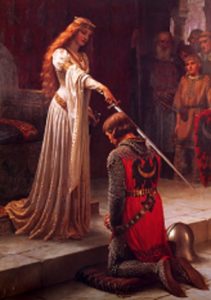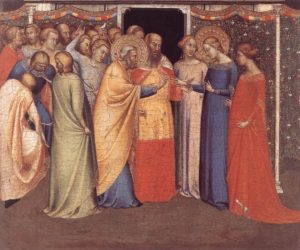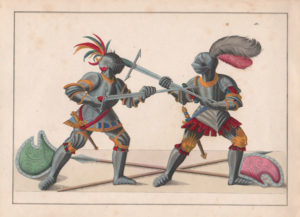 As part of my studies of the martial arts of Medieval and Renaissance Europe, I specifically looked at the history of knights, especially those of the Catholic Military Orders (e.g. The Knights of Saint John/Malta/Hospitaller, Teutonic Knights, etc.). In the course of that reading, I came across an article from Patrick Meehan, published at the Medievalists.net website in 2014. The author writes about the history of knights and how the actions of these historical figures runs the gamut from violent and destructive to the courtesies of courtly life. The author goes on to discuss the happenings in the lives of 3 different knights – an anonymous knight in the Teutonic Knights, Ulrich von Lichtenstein, and Jӧrg von Ehingen. The lives of these three men were distinctly different and spanned 200 years of history, but there was a common thread that linked them together and linked them to us – and the key to understanding that linkage lies in the Theology of the Body.
As part of my studies of the martial arts of Medieval and Renaissance Europe, I specifically looked at the history of knights, especially those of the Catholic Military Orders (e.g. The Knights of Saint John/Malta/Hospitaller, Teutonic Knights, etc.). In the course of that reading, I came across an article from Patrick Meehan, published at the Medievalists.net website in 2014. The author writes about the history of knights and how the actions of these historical figures runs the gamut from violent and destructive to the courtesies of courtly life. The author goes on to discuss the happenings in the lives of 3 different knights – an anonymous knight in the Teutonic Knights, Ulrich von Lichtenstein, and Jӧrg von Ehingen. The lives of these three men were distinctly different and spanned 200 years of history, but there was a common thread that linked them together and linked them to us – and the key to understanding that linkage lies in the Theology of the Body.
On the surface it seems rather implausible that the Theology of the Body, written by Saint John Paul II over the course of several years, which deals with sexuality can create a link to men who lived 800 years earlier and who were known for their fighting skills. Love and war? Always interesting topics, regardless of the generation.
In the Theology of the Body, St. John Paul II delves into the interpersonal love of spouses and how the one flesh union is a visible sign of God’s love made present in the sacrament of Holy  Matrimony. God’s love has four components – it must be free, total, faithful, and fruitful. So to, should the love between spouses exhibit these four elements and marriages suffer when they are absent. First is freedom – we must be free to marry our spouse. Which means not only that we are not married to another, but also that we are not forcing our spouse to do something and we are able to forsake relations with all others. Next is total, the love must be total and one spouse should not say “I give you everything, except…” Totality also includes forever, which is why a prenuptial agreement is an impediment to a sacramental marriage as it presupposes failure and you have not committed to give your spouse your entire future. Faithfulness is third on the list and it should be clear, at least on the physical level, of the importance of faithfulness. This also refers to faithfulness in word and in thought – engaging in fantasies about others is unfaithful too. And finally fruitful, which describes how physical relations between spouses need to be open to life, though not necessarily timed to generate a life. This vision of spousal love is a total gift of self to the vocation of marriage – our work, our play, and our faith life are centered on our spouse and any children that arise from this union.
Matrimony. God’s love has four components – it must be free, total, faithful, and fruitful. So to, should the love between spouses exhibit these four elements and marriages suffer when they are absent. First is freedom – we must be free to marry our spouse. Which means not only that we are not married to another, but also that we are not forcing our spouse to do something and we are able to forsake relations with all others. Next is total, the love must be total and one spouse should not say “I give you everything, except…” Totality also includes forever, which is why a prenuptial agreement is an impediment to a sacramental marriage as it presupposes failure and you have not committed to give your spouse your entire future. Faithfulness is third on the list and it should be clear, at least on the physical level, of the importance of faithfulness. This also refers to faithfulness in word and in thought – engaging in fantasies about others is unfaithful too. And finally fruitful, which describes how physical relations between spouses need to be open to life, though not necessarily timed to generate a life. This vision of spousal love is a total gift of self to the vocation of marriage – our work, our play, and our faith life are centered on our spouse and any children that arise from this union.
Before we begin looking at the knights, the reader should be aware that there were two different kinds of knighthood. The first was the secular – a man swore his oath of allegiance to a particular king, while the second kind of knighthood was by being a member of a religious Military Order (taking vows similar to a religious brother) – these would include Knights Hospitaller, Knights Templar, etc. These two distinct ways of life in knighthood existed side-by-side during the Medieval and Renaissance periods.
Again we might ask – how does this relate to knights, martial arts and sword fighting? While there are obvious differences between marriage and living the life of a warrior (at least we hope so!), the underlying Catholic faith of the knights and the spouses is the same and so the principles which undergird both should be (and are) quite similar. In an analogous way to marriage, the knights had to be free, total, faithful, and fruitful to their vocation too. Knights not only had to freely agree to serve, but they had to be free of impediments that might divide their loyalty (such as a wife and family for the religious Knights). There was a totality of service, especially in the military orders of the Church, whereby knights gave their money to the Order and turned over any property to the Order. As an example of their faithfulness Knights were expected, and often did, sacrifice their bodies in service to the leader or kingdom they swore fealty to. The fruitfulness that a Knight was called to is certainly different than that of the spousal relationship, though also of great value during this period. Knights were expected to be fruitful in their works and in the defense of the subjects of a kingdom or members of the faith (for the religious Knights). Another way that knights fulfilled their call to be fruitful, was to take on boys as pages to be trained, promoted to squires, and finally to become knights in their own right. The process lasted about 14 years and during that time these boys and young men would live with their knight instead of their family.
agree to serve, but they had to be free of impediments that might divide their loyalty (such as a wife and family for the religious Knights). There was a totality of service, especially in the military orders of the Church, whereby knights gave their money to the Order and turned over any property to the Order. As an example of their faithfulness Knights were expected, and often did, sacrifice their bodies in service to the leader or kingdom they swore fealty to. The fruitfulness that a Knight was called to is certainly different than that of the spousal relationship, though also of great value during this period. Knights were expected to be fruitful in their works and in the defense of the subjects of a kingdom or members of the faith (for the religious Knights). Another way that knights fulfilled their call to be fruitful, was to take on boys as pages to be trained, promoted to squires, and finally to become knights in their own right. The process lasted about 14 years and during that time these boys and young men would live with their knight instead of their family.
We are often called to submit our bodies to our vocation – from the pregnant woman, to the spouse who works hours to provide for the family, or the knight who endures the pain of training and battle. Beyond the dedication of one’s sexuality to one’s spouse, there is also the dedication of our bodies to other aspects of our family.
In our current, sex-saturated culture, the ideas embodied in the Theology of the Body are considered both revolutionary and impossible. But to the faithful, the idea of pledging oneself to his or her vocation is nothing new. As Mr. Meehan points out in his article “knights of the Order submitted their bodies to violence,” and though that kind of dedication seems nearly impossible to modern thinking, the corollary thought of dedicating one’s sexuality to their vocation seems totally unthinkable. However, seen through the eyes of faith, this dedication to a mission from God bridges the gap of 1,000 years and ties together the medieval and modern members of the Church founded by Jesus.